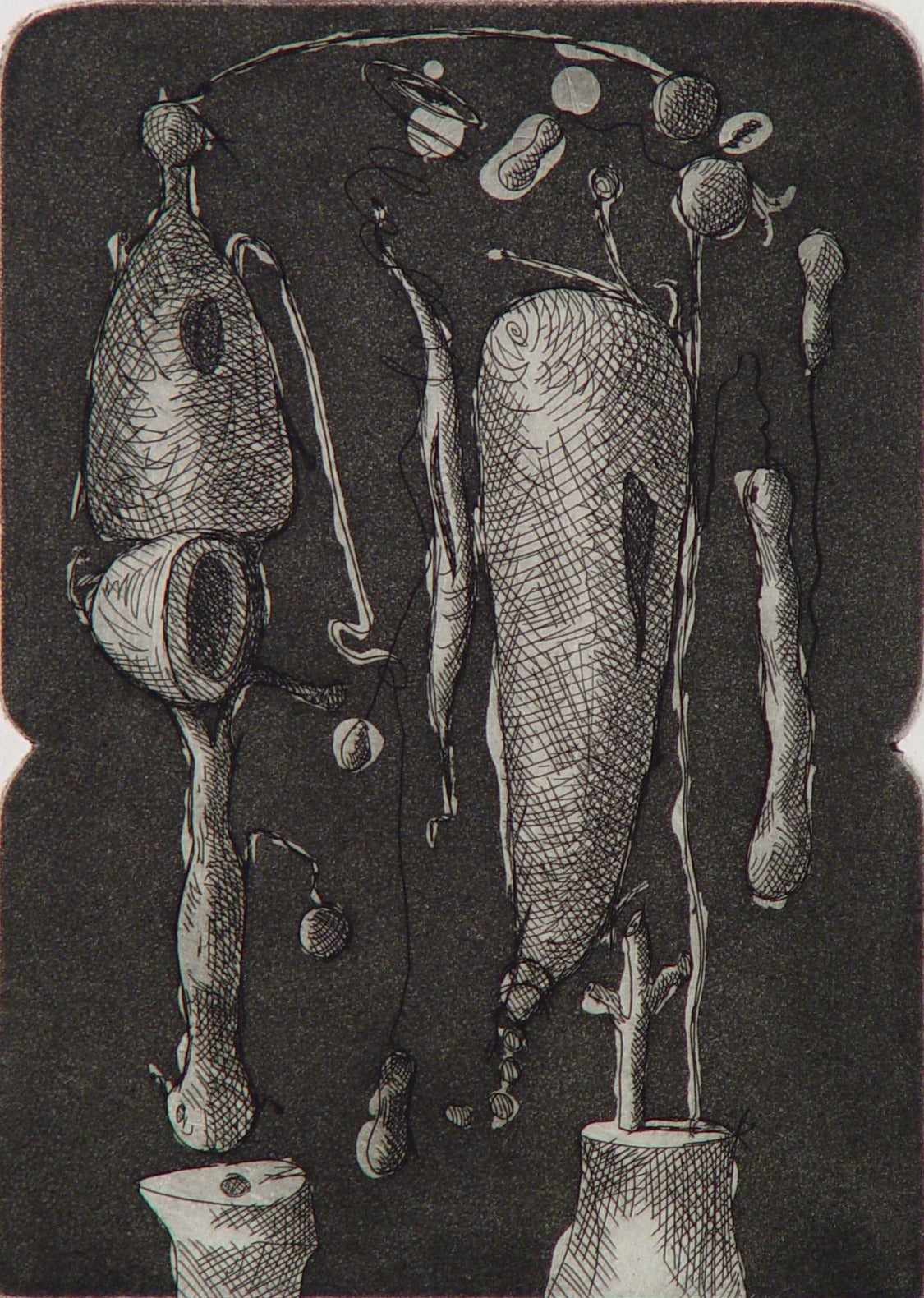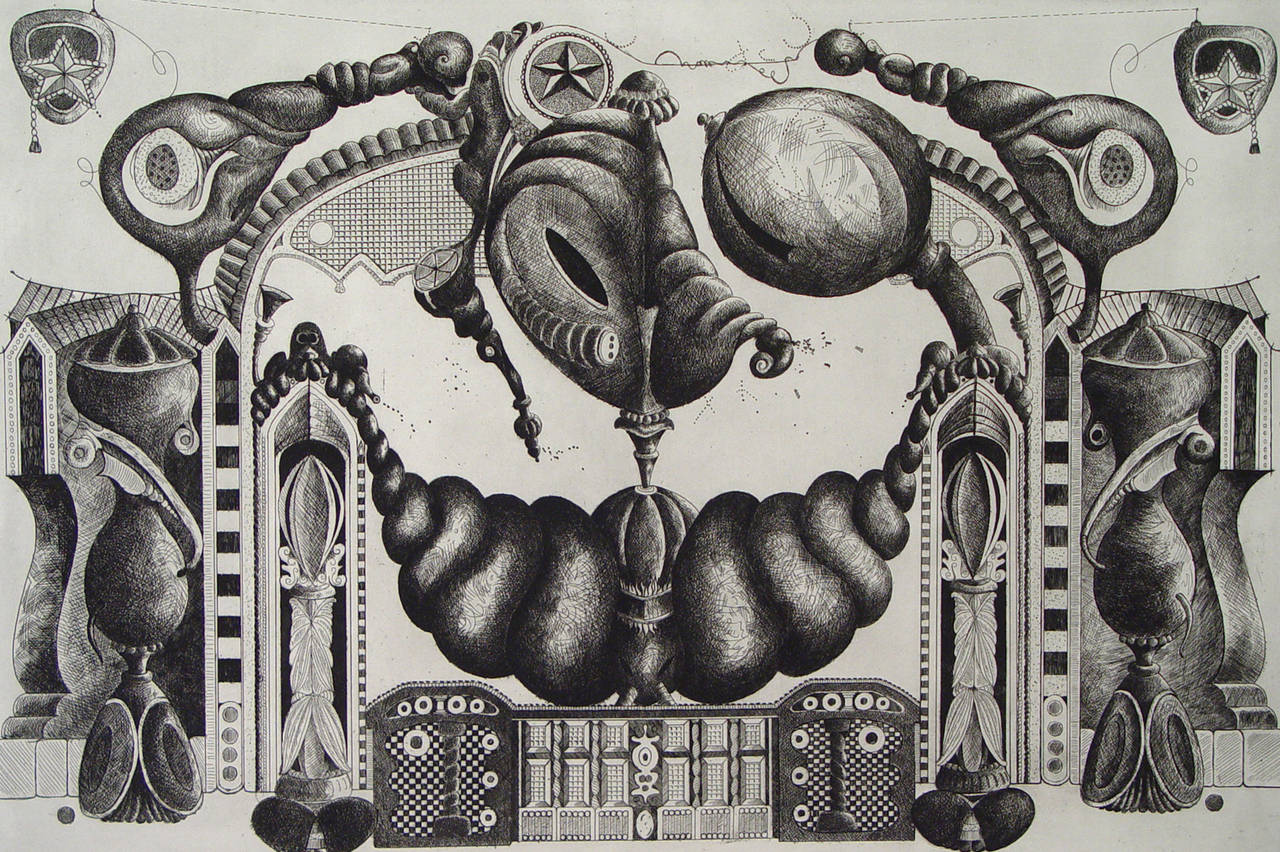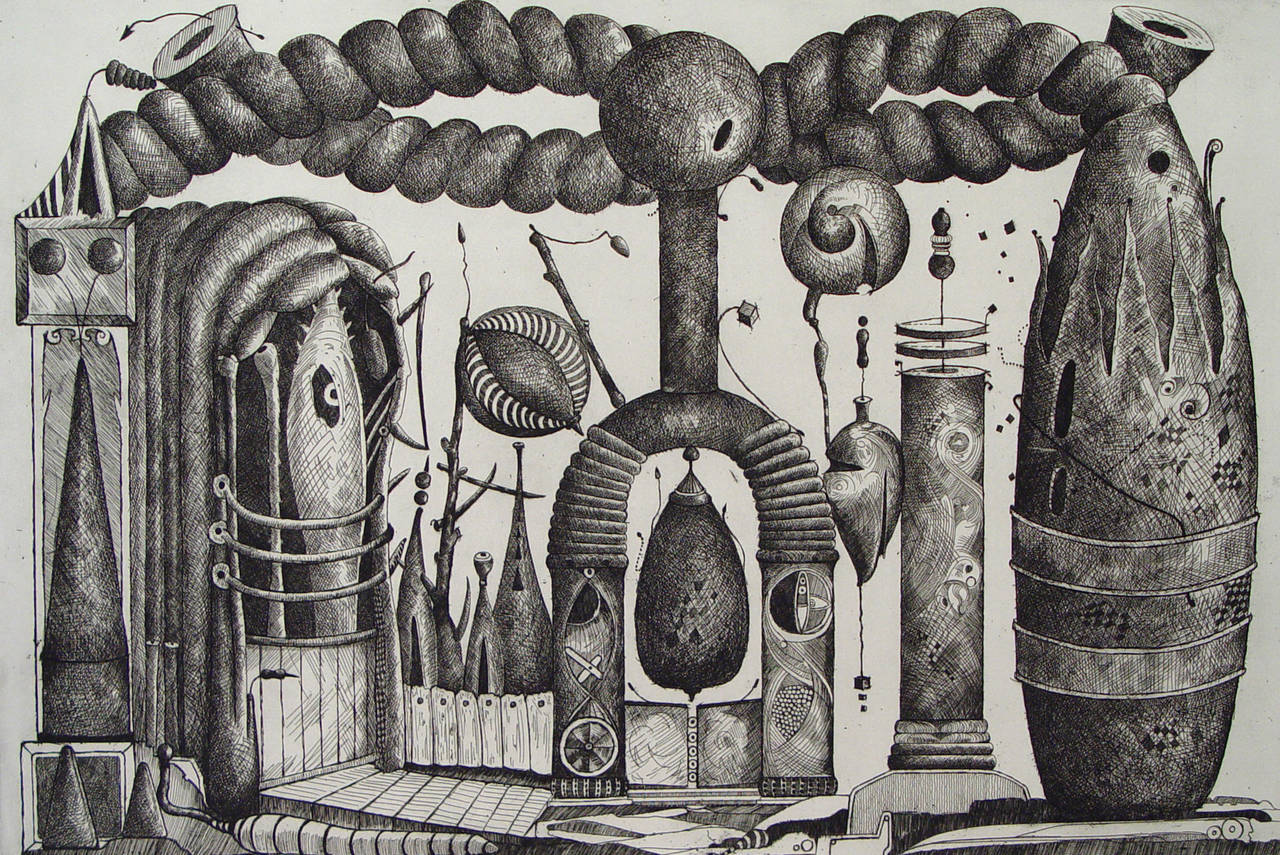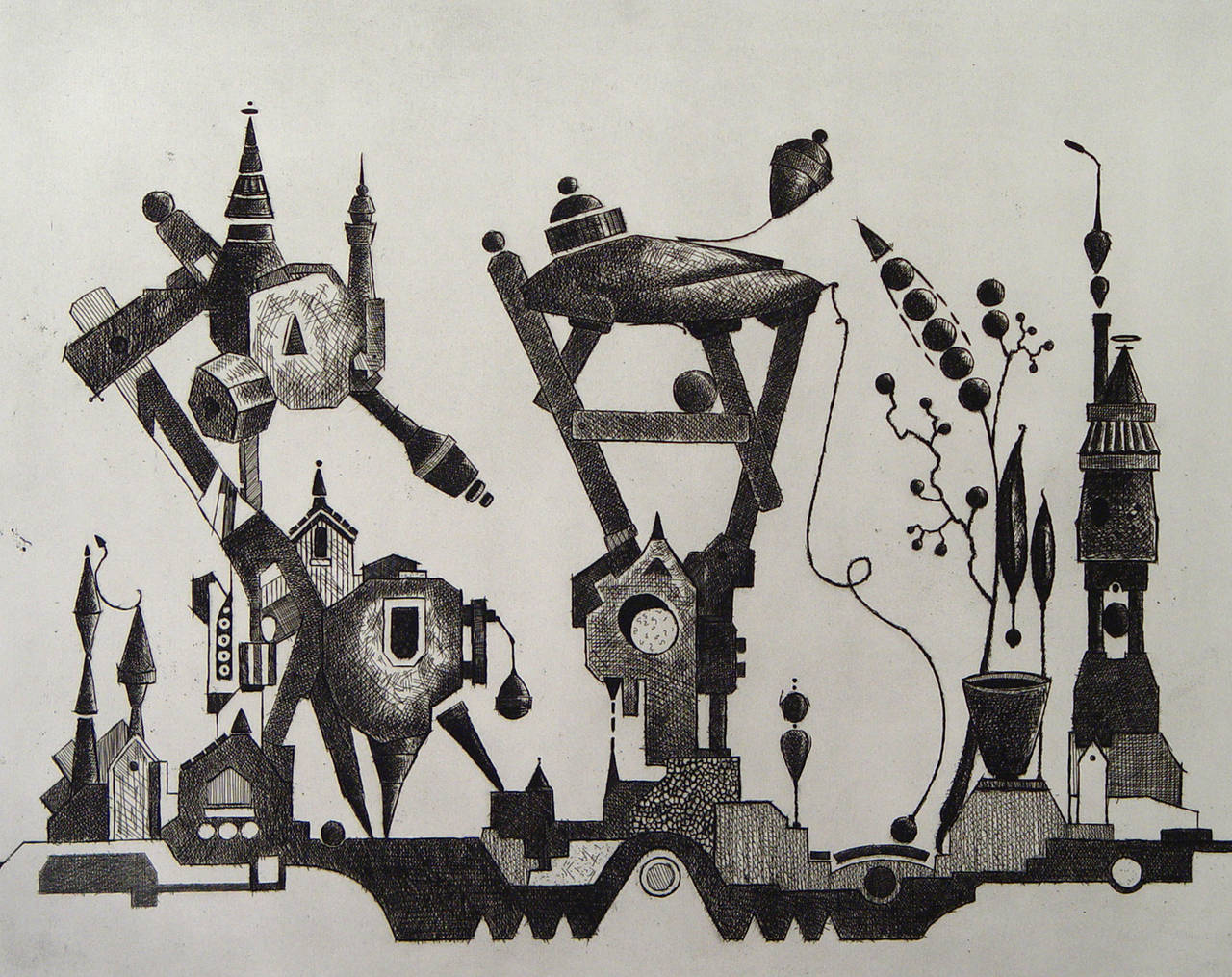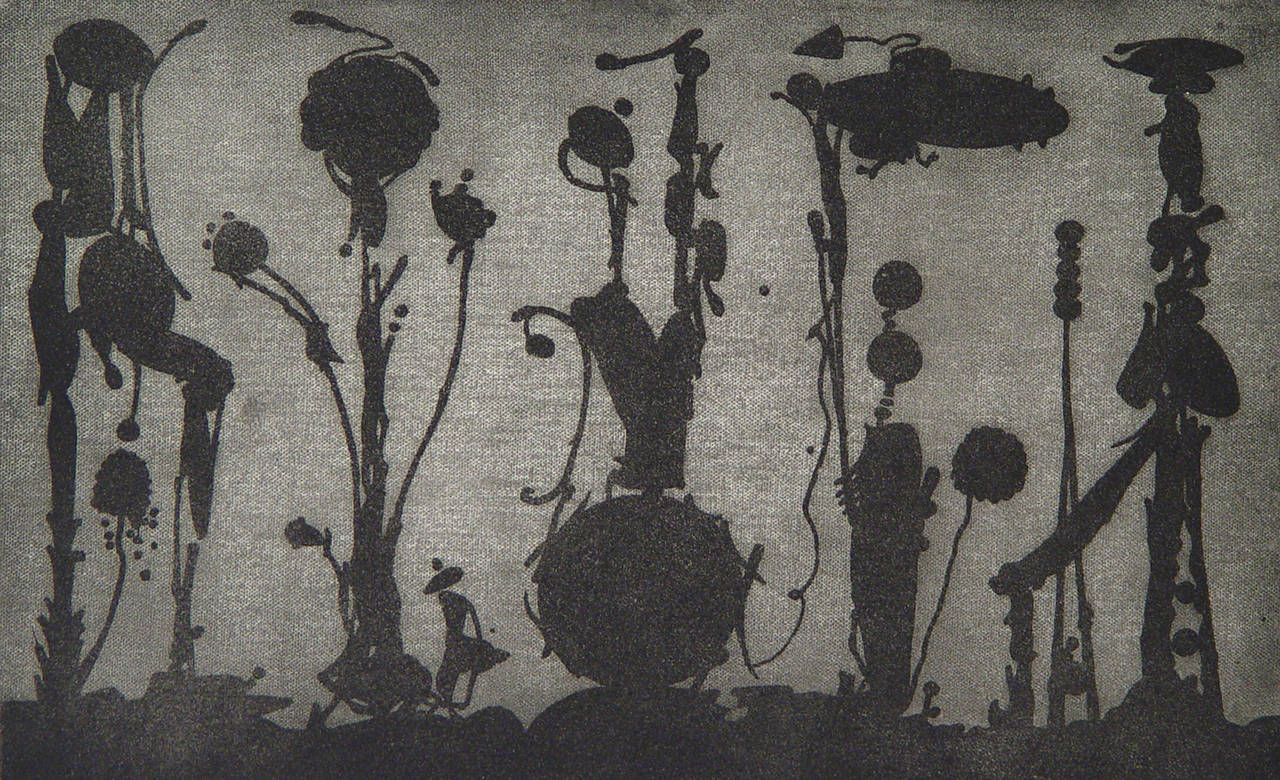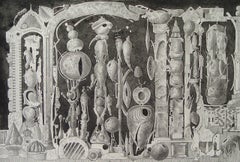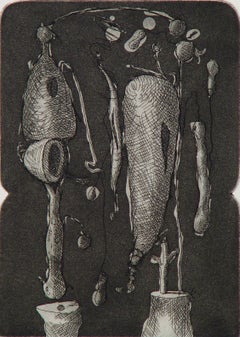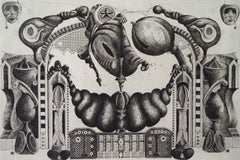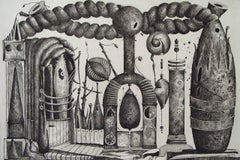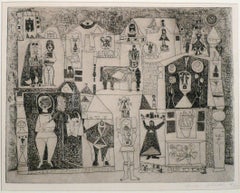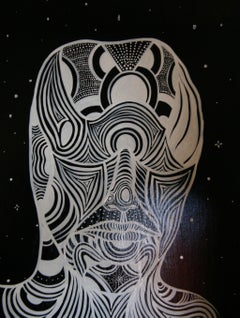Want more images or videos?
Request additional images or videos from the seller
1 of 5
Valton TylerDo Not Touch1970
1970
Price Upon Request
Price Upon Request
Price Upon Request
Price Upon Request
Price Upon Request
Price Upon Request
Price Upon Request
Price Upon Request
Price Upon Request
Price Upon Request
About the Item
In The New York Times Arts in America column, Edward M. Gomez wrote of Valton Tyler, "visionary seems the right word for describing his vivid, unusual and technically refined paintings, prints and drawings, whose style defies convenient labels. Abstract, surreal, cartoonish, sci-fi fantastic, metaphysical, apocalyptic-Baroque - all of these fit but also fall short of fully describing his art." (The Living Arts, June 13, 2000, p. B2)
Valton Tyler was born in 1944 in Texas, where "the industrial world of oil refineries made a long-lasting impression on Valton as a very young child living in Texas City. He was three years old when the terrible explosion occurred there and can remember the terrifying confusion and 'the beautiful red sky and objects flying everywhere in the air.'" (Reynolds, p. 25) While growing up in Texas City, Valton's father worked in auto repair, and was known for his skill in mixing colors for paint jobs. After leaving Texas City, Valton made his way to Dallas, where he briefly enrolled at the Dallas Art Institute, but found it to be too social and commercial for his taste. After Valton's work was introduced to Donald Vogel (founder of Valley House Gallery), "Vogel arranged for Tyler to use the printmaking facilities in the art department of the Southern Methodist University in Dallas, where the young artist essentially taught himself several demanding printmaking techniques. 'It was remarkable,' Vogel says. 'Not only did he learn complicated etching methods, but he was able to express himself powerfully in whatever medium he explored.' Vogel became the publisher of Tyler's prints. Among them, the artist made editions of some 50 different images whose sometimes stringy abstract forms and more solid, architecturally arresting elements became the precursors of his later, mature style." (Gomez, Raw Vision #35, p. 36)
“Do Not Touch” is plate number 20, and is reproduced in "The First Fifty Prints: Valton Tyler" with text by Rebecca Reynolds, published for Valley House Gallery by Southern Methodist University Press, Dallas, Texas, 1972.
In “The First Fifty Prints,” Reynolds wrote, “An understanding of the technical methods used in this plate is important in discussing the purpose of this design. As Mr. Scholder has described the process, Valton first draws an outline of the design with felt pen on tracing paper. This outline is then transferred onto the plate. The next stage in this case was to cover the areas which are white in the finished print with stop-out varnish and to spray the exposed areas with spray paint. When the plate is immersed in an acid solution, only the tiny spots not protected with the paint are bitten. Through this use of aquatint, Valton achieved the fuzzy texture of the black background. Returning to the design, overlaid with hard ground, he then scratched in the patterning of the lines. Hard ground was again applied to protect the finished background, the plate was again submerged in the acid, and the lines were then etched.”
Reynolds continues, “The order of these technical stages and the resulting white silhouette against a black ground create an X-ray view, or negative, that focuses on what Valton feels is the backbone of his designs. The patterns of simple parallel lines we see here are the only elements that model, define, and animate the forms, and not the use of contour line. He has intended to diagram and emphasize in this plate the role his line performs and the magic it creates when further developed in such intricate plates as “Heritage,” Plate No. 25, “Together We Are,” Plate No. 27, and “A New Born Day,” Plate No. 50.” (Reynolds, p. 76)
Paper size: 21 1/4 x 23 inches
Edition: 5 Artists Proofs Imp. 50 Signed Prints Imp.
Bibliography:
Edward M. Gomez, "Futuristic Forms Frolic Under Eerie Texan Skies," The New York Times, June 13, 2000, page B2.
Edward M. Gomez, "Valton Tyler's Techno-Organic Landscapes," Raw Vision 35, Summer 2001, pages 34-39.
Rebecca Reynolds, "The First Fifty Prints: Valton Tyler," published for Valley House Gallery by Southern Methodist University Press, Dallas, Texas, 1972.
- Creator:Valton Tyler (1944, American)
- Creation Year:1970
- Dimensions:Height: 15.75 in (40.01 cm)Width: 17.75 in (45.09 cm)
- Medium:
- Movement & Style:
- Period:
- Condition:
- Gallery Location:Dallas, TX
- Reference Number:Seller: VT-201stDibs: LU257291382
About the Seller
5.0
Recognized Seller
These prestigious sellers are industry leaders and represent the highest echelon for item quality and design.
Established in 1954
1stDibs seller since 2013
162 sales on 1stDibs
Typical response time: 11 hours
Associations
Art Dealers Association of America
- ShippingRetrieving quote...Shipping from: Dallas, TX
- Return Policy
Authenticity Guarantee
In the unlikely event there’s an issue with an item’s authenticity, contact us within 1 year for a full refund. DetailsMoney-Back Guarantee
If your item is not as described, is damaged in transit, or does not arrive, contact us within 7 days for a full refund. Details24-Hour Cancellation
You have a 24-hour grace period in which to reconsider your purchase, with no questions asked.Vetted Professional Sellers
Our world-class sellers must adhere to strict standards for service and quality, maintaining the integrity of our listings.Price-Match Guarantee
If you find that a seller listed the same item for a lower price elsewhere, we’ll match it.Trusted Global Delivery
Our best-in-class carrier network provides specialized shipping options worldwide, including custom delivery.More From This Seller
View AllJust a Little Water Please
By Valton Tyler
Located in Dallas, TX
In The New York Times Arts in America column, Edward M. Gomez wrote of Valton Tyler, "visionary seems the right word for describing his vivid, unusual and technically refined paintin...
Category
1960s Outsider Art Abstract Prints
Materials
Rag Paper, Etching, Aquatint
Price Upon Request
Love Me
By Valton Tyler
Located in Dallas, TX
In The New York Times Arts in America column, Edward M. Gomez wrote of Valton Tyler, "visionary seems the right word for describing his vivid, unusual and technically refined paintin...
Category
1970s Outsider Art Abstract Prints
Materials
Rag Paper, Etching
Price Upon Request
Heritage
By Valton Tyler
Located in Dallas, TX
In The New York Times Arts in America column, Edward M. Gomez wrote of Valton Tyler, "visionary seems the right word for describing his vivid, unusual and technically refined paintin...
Category
1960s Outsider Art Abstract Prints
Materials
Rag Paper, Etching, Aquatint
Price Upon Request
Together We Are
By Valton Tyler
Located in Dallas, TX
In The New York Times Arts in America column, Edward M. Gomez wrote of Valton Tyler, "visionary seems the right word for describing his vivid, unusual and technically refined paintin...
Category
1960s Outsider Art Abstract Prints
Materials
Rag Paper, Etching
Price Upon Request
Stop Playing and Get to Work
By Valton Tyler
Located in Dallas, TX
In The New York Times Arts in America column, Edward M. Gomez wrote of Valton Tyler, "visionary seems the right word for describing his vivid, unusual and technically refined paintin...
Category
1960s Outsider Art Abstract Prints
Materials
Rag Paper, Etching
Price Upon Request
Height Almost 34'
By Valton Tyler
Located in Dallas, TX
In The New York Times Arts in America column, Edward M. Gomez wrote of Valton Tyler, "visionary seems the right word for describing his vivid, unusual and technically refined paintings, prints and drawings, whose style defies convenient labels. Abstract, surreal, cartoonish, sci-fi fantastic, metaphysical, apocalyptic-Baroque - all of these fit but also fall short of fully describing his art." (The Living Arts, June 13, 2000, p. B2)
Valton Tyler was born in 1944 in Texas, where "the industrial world of oil refineries made a long-lasting impression on Valton as a very young child living in Texas City. He was three years old when the terrible explosion occurred there and can remember the terrifying confusion and 'the beautiful red sky and objects flying everywhere in the air.'" (Reynolds, p. 25) While growing up in Texas City, Valton's father worked in auto repair, and was known for his skill in mixing colors for paint jobs. After leaving Texas City, Valton made his way to Dallas, where he briefly enrolled at the Dallas Art Institute, but found it to be too social and commercial for his taste. After Valton's work was introduced to Donald Vogel (founder of Valley House Gallery), "Vogel arranged for Tyler to use the printmaking facilities in the art department of the Southern Methodist University in Dallas, where the young artist essentially taught himself several demanding printmaking techniques. 'It was remarkable,' Vogel says. 'Not only did he learn complicated etching methods, but he was able to express himself powerfully in whatever medium he explored.' Vogel became the publisher of Tyler's prints. Among them, the artist made editions of some 50 different images whose sometimes stringy abstract forms and more solid, architecturally arresting elements became the precursors of his later, mature style." (Gomez, Raw Vision #35, p. 36)
“Height...
Category
1970s Outsider Art Abstract Prints
Materials
Rag Paper, Aquatint
Price Upon Request
You May Also Like
Sub Culture
By Caroline Durieux
Located in San Francisco, CA
This artwork titled "Sub Culture" c1972 is an original color lithograph on wove paper by noted New Orleans artist Caroline Spellman Wogan Durieux, 1896-1989. It is hand signed, titled, dated and numbered 5/10 in pencil by the artist. The image size is 17.75 x 13 inches, sheet size is 19.85 x 15 inches. It is in excellent condition, some hanging tape from previous framing remaining on the back.
About the artist:
As a Southern female satirist, Caroline Spellman Wogan Durieux was a rare phenomenon in the early twentieth century. Today, she is highly regarded for her stinging lithographs that touch on human foibles as well as some of the important issues of her day. Born to a family of Creole descent in New Orleans, young Caroline was precocious; she began drawing at age four and completed a portfolio of watercolors depicting her city by the time she was twelve. She took lessons from Mary Butler, a member of the art faculty at Sophie Newcomb College, and, beginning in 1912, matriculated at the school full-time, where her instructors included Ellsworth Woodward, chair of the art department. She graduated with a bachelor’s degree in design in 1916 and one in education in 1917. Awarded a scholarship by the New Orleans Art Association, Durieux pursued further coursework at the Pennsylvania Academy of the Fine Arts from 1918 to 1920. Years later, she was encouraged to try lithography by Carl Zigrosser, an expert curator of prints at the Philadelphia Museum of Art, who became her mentor.
With her husband Pierre Durieux—an importer of Latin American goods and later the chief representative of General Motors for South America—Caroline Durieux spent time in Cuba during the early 1920s. The couple moved in 1926 to Mexico City, where she met the great muralist Diego Rivera and became involved in the local art community. Following a short interval in New York City, Durieux went back to Mexico in 1931 and enrolled at the Academy of San Carlos (now the National University of Mexico) to study lithography.
She returned to New Orleans seven years later and was hired to teach at her alma mater, Newcomb College, from 1938 to 1943. Starting in 1939, Durieux served as the director of Louisiana’s Works Progress Administration program, and her division was the only one in the state not to practice racial discrimination. This was a matter she felt strongly about, stating: “I had a feeling that an artist is an artist and it doesn’t make any difference what color he or she is.” From 1943 until her retirement in 1964, Durieux was a member of the faculty at Louisiana State University in Baton Rouge.
Durieux’s forte was lithography, a technique popular in the mid-nineteenth century and long associated with social commentary, and her prints proved no exception. Her work in the 1930s and 1940s coincided with a rise in art that dealt with poverty, racism, and totalitarianism. She often presented stereotyped social climbers...
Category
Late 20th Century American Modern Figurative Prints
Materials
Lithograph
UNTITLED
By Ynez Johnston
Located in Portland, ME
Johnston, Ynez. UNTITLED. Etching, not dated (but likely 1950s). Edition of 20, signed in pencil and numbered 4/20. 6 7/8 x 9 inches (plate), 8 x 10 5/8 inches (sheet). In excellent ...
Category
1950s Abstract Prints
Materials
Etching
$1,400
Alpha 1
Located in Santa Monica, CA
Original multi-panel Alexander McVickar Acrylic and mixed media painting. Measurements include 1/2 in spacing between each panel.
Category
21st Century and Contemporary Outsider Art Mixed Media
Materials
Mixed Media, Acrylic
$2,320 Sale Price
20% Off
The future of man
By Mike Maxwell
Located in Santa Monica, CA
Acyrlic
Category
2010s Outsider Art Figurative Paintings
Materials
Acrylic
Elements of Time & Space
By Katie VanVliet
Located in Philadelphia, PA
Intaglio on Somerset paper, edition of 4
The artwork is shipped unframed. Please message us directly if you are interested in purchasing the piece already framed.
Bio // Katie Van...
Category
21st Century and Contemporary Contemporary More Prints
Materials
Archival Paper, Intaglio
The space displacement
By Barbara Kuebel
Located in New Orleans, LA
edition 1/5
BARBARA KUEBEL is a Daphne, AL-based artist who uses oil and pencil for her works on paper and on canvas. She was born and raised in Austria and earned two art degrees f...
Category
21st Century and Contemporary Contemporary Prints and Multiples
Materials
Paper, Woodcut
More Ways To Browse
Sophie Taeuber Arp Print
The Brothers Karamazov
Totem Mario
Tracey Emin Towel
Twombly Poster
Tyler Mitchell
Vera Molnar
Vincent Gordon
Vintage Original Posters Otis Redding
W Hoffman
Walker Art Center Poster
Warhol Art Cash
Warhol Pasadena
Wassily Kandinsky 1911
Yaacov Agam Rainbow
Yaacov Agam Star
Yoshitomo Nara Skateboard
Zao Wou Ki Signed

